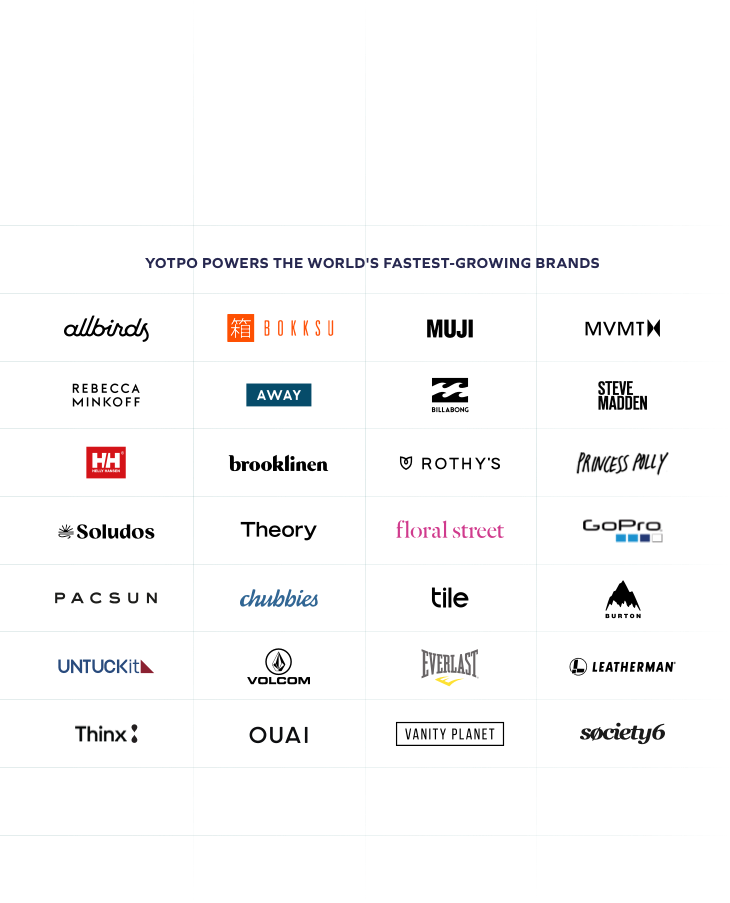“Yotpo is a fundamental part of our recommended tech stack.”
 Laura Doonin, Commercial Director
Laura Doonin, Commercial Director
How to Scale Your Business By Automating Your Marketing
Michael Perry is the Director of Kit at Shopify. Kit, which was recently acquired by Shopify, is a fully automated virtual marketing assistant that helps make life easier for growing businesses. Michael has extensive knowledge of eCommerce CRM tools and innately understands the importance of helping make life easier for businesses as they grow. In this lesson, he shares what he’s learned about how business owners can automate marketing to spend more time on the tasks that matter most.
Marketing is the engine behind all of your sales. Yet when it comes to scaling eCommerce marketing plans, the specific growing pains for an online business depend on the stage of your business and the size of your team.
Regardless of how big your company is now, when you started your eCommerce business, you were likely going at it alone, trying to juggle many competing to do’s at once. Even with an established vision and plan, actually achieving marketing goals will be a constant growing pain as long as there is one person at the helm.
But size isn’t everything. Businesses with an all-star marketing team also need to make sure that they are allocating their time and resources wisely.
It really all comes down to priorities.
Being everywhere at once just isn’t scalable, and keeping up with the best practices on every platform is an uphill battle, so it’s important to come to terms with the fact that you don’t have time to do everything everywhere.
As your business grows, your time will shrink, so ask yourself the big questions as early as possible: Do you need to be marketing everywhere from the get-go? Or should you master a couple of channels to achieve really strong brand awareness in a few places?
Bottom line: What is going to get you the best results?
When you’re running a business, you don’t have time to waste anywhere – but cutting corners in marketing won’t get you the results you need. So what’s a time-strapped business owner to do?
Many marketers are turned off by automation because they are wary of the logistics necessary to get it up and running.
Others worry that relying on automation will result in mistakes. But think about how much time you’ll save in the long run by investing now in automation.
Running a promotional sale or sending an email announcing your newest product line to all of your existing customers could be as simple as sending a text message.
That would mean that you could check off these high-value marketing tasks while working in your studio or on your way to a meeting with a supplier.
Too many eCommerce stores let marketing and brand visibility fall by the wayside because there just aren’t enough hours in the day.
But if you put so much effort and resources into acquiring customers, you should do all you can to maximize your relationship with them.
Automation allows you to optimize your efforts in the early stages and ultimately give your business more freedom.
Every consumer has a problem to solve. Think about it: if it’s cold outside, you need a way to stay warm. In this case, the problem is that it’s cold outside and the solution could be a sweater.
The “Jobs to Be Done” approach works by identifying customer motivations for seeking out a given product and coming up with possible solutions.
The basic foundation of the Jobs to Be Done mindset is that people seek out products because they have a problem and they are looking for a way to solve it. The problem they need a solution for is the Job to Be Done.
When the starting point of a project is the unsolved problem–the Job to Be Done–it welcomes creativity from the solution provider because the possibilities are wide open.
In the case of eCommerce marketing automation, your business is the consumer. You define the Job to Be Done and automation technologies are the solution providers challenged with bridging that gap.
Regardless of what your Job to Be Done is, there’s an automation app that can lighten the load for you.
Automation solutions can take some of the more granular and tactical tasks off your shoulders in areas like email marketing, social media, inventory, SEO and customer feedback so that your working hours aren’t spent bogged down with the small stuff.
Email communications to your customer base, social media posts, seasonal promotions, redirecting traffic away from broken links and moderating customer feedback are all tasks that can me automated.
Look at what jobs you need to get done. If you were to hire someone new right now, what problem would you be trying to solve? Identify if your current employees are wasting their talent on tasks that could easily be automated, and if they could instead invest in areas that need a human touch.
As you scale, it is crucial to keep customer relationships strong. But this is one of those aspects of your business that can’t sustainably be handled the same way as when you first started. You can’t individually respond to every customer email, and you can’t single-handedly manage every engagement.
One way to handle this is by letting customers take care of each other. Build communities where they can ask and answer each other’s questions. Allow shoppers to get the relatable product information they really want by reading customer reviews, or solve their fears about fit by looking at customer photos.
Automating customer relationships may sound dangerous at first – after all, your customers are the core of your business. But in reality, this is probably the easiest and most beneficial aspect to automate. Making it easy for customers to share their experiences with each other harnesses the social proof that drives consumer behavior.
User-generated content like customer reviews and photos has become a popular marketing tool for all businesses, but especially for eCommerce because the buying and selling experiences of offline and online businesses are radically different. For online businesses, customer contribution reassures shoppers in the discovery phase, boosts their confidence during the purchase decision process, and builds credibility around your brand.
Our world is more connected than ever, peer-to-peer sharing is at an all-time high, and the market is full of products in every category. What sets a store apart relies completely on what customers have to say.
Automating the collection and distribution of your user-generated content allows you not only to boost sales, but also to save yourself time and drive more relevant traffic. Furthermore, you can gain a leg up by using it as your tool to gain insight into customer interests, concerns, feedback, and ultimately–where you may need to implement automation.
It’s time to free yourself from worrying about each and every detail of your marketing activities. Invest in automation, and let your customers do the talking.
“Yotpo is a fundamental part of our recommended tech stack.”
 Laura Doonin, Commercial Director
Laura Doonin, Commercial Director







